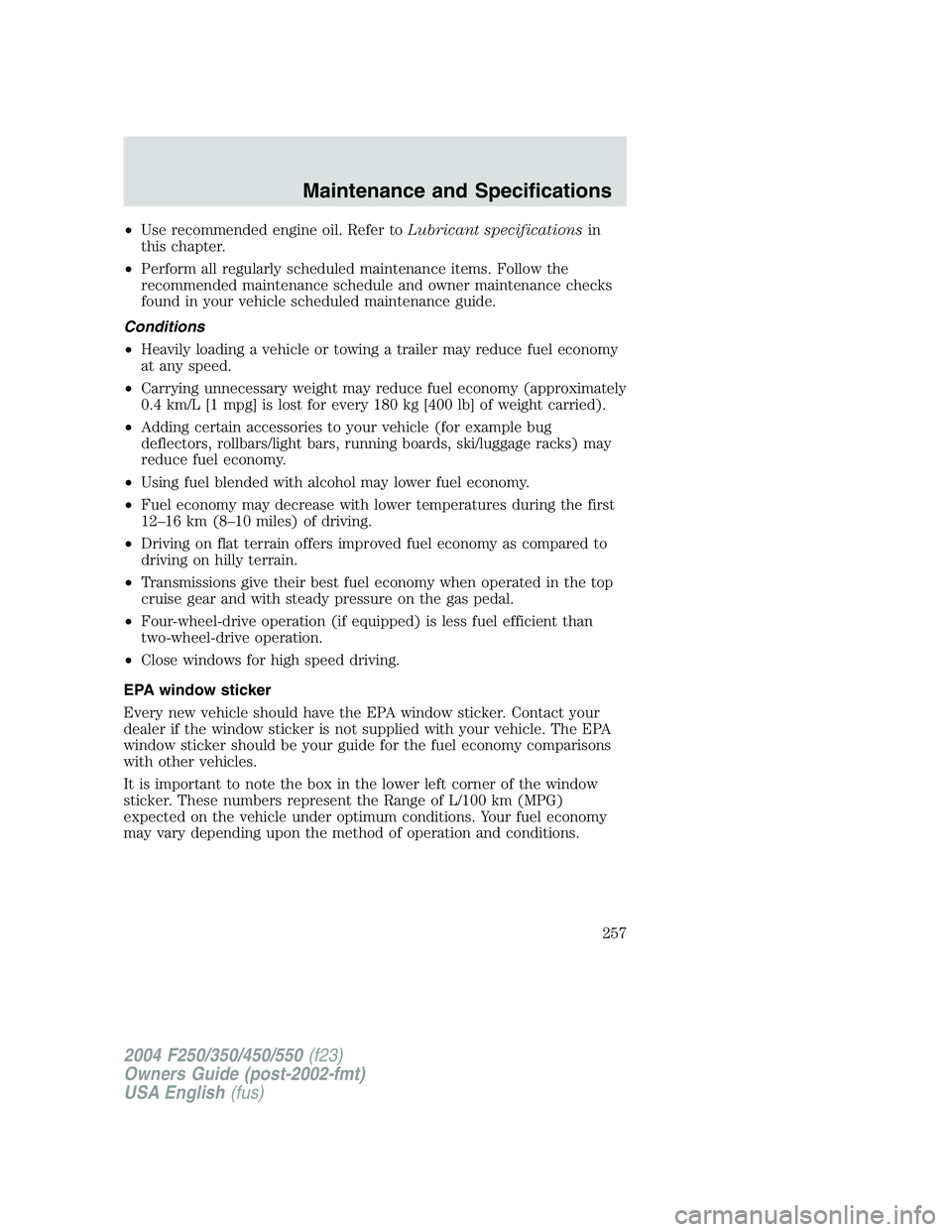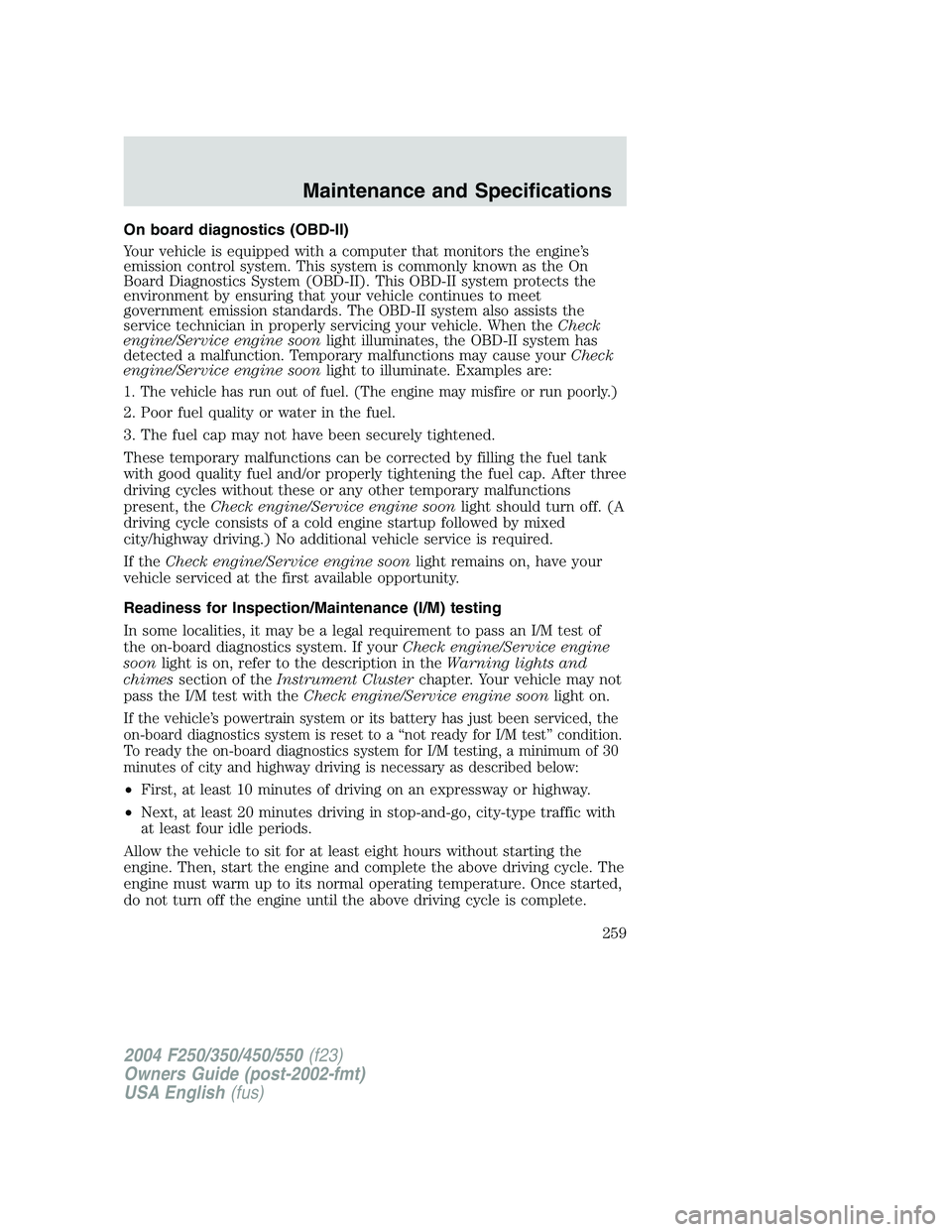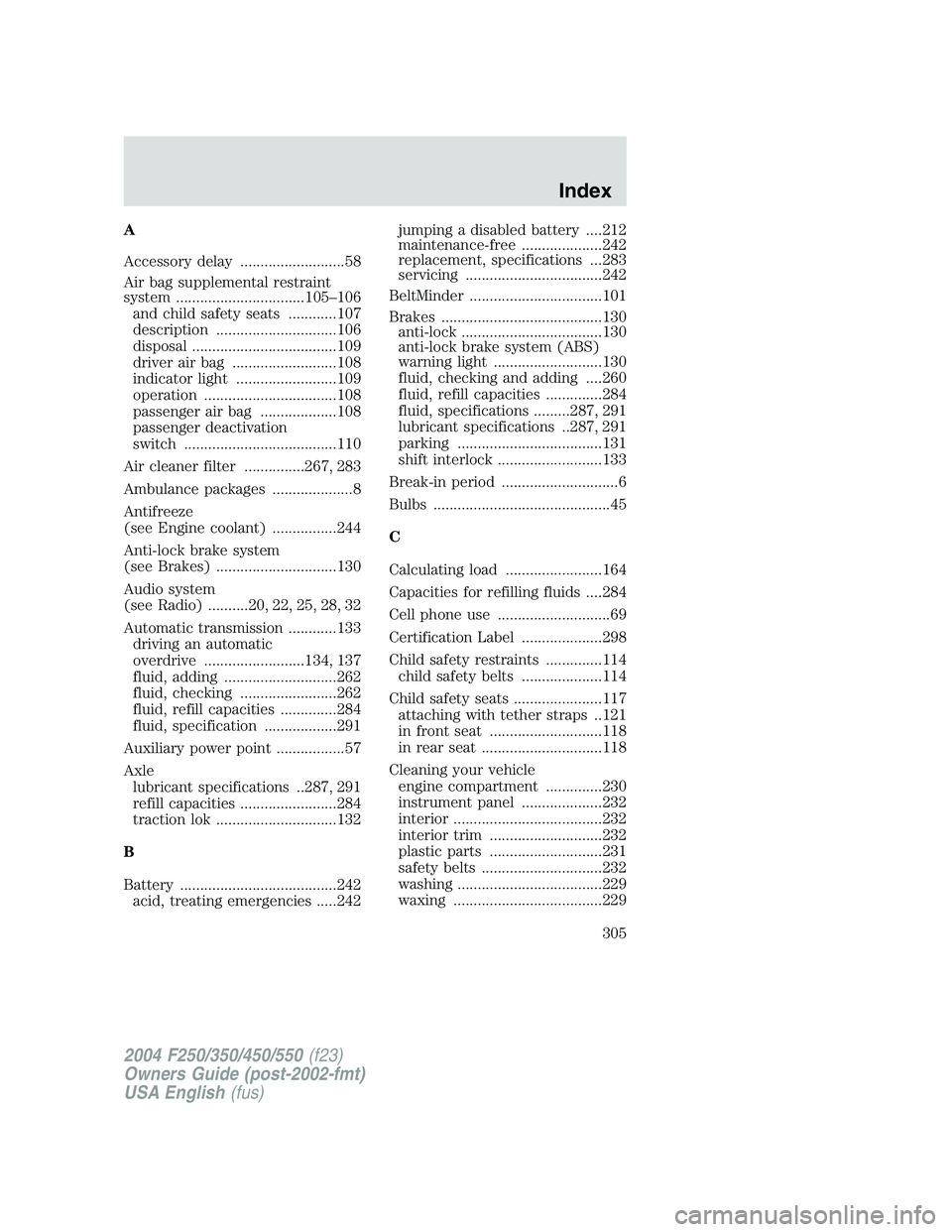check engine light FORD F250 2004 User Guide
[x] Cancel search | Manufacturer: FORD, Model Year: 2004, Model line: F250, Model: FORD F250 2004Pages: 312, PDF Size: 2.66 MB
Page 257 of 312

•Use recommended engine oil. Refer toLubricant specificationsin
this chapter.
•Perform all regularly scheduled maintenance items. Follow the
recommended maintenance schedule and owner maintenance checks
found in your vehicle scheduled maintenance guide.
Conditions
•Heavily loading a vehicle or towing a trailer may reduce fuel economy
at any speed.
•Carrying unnecessary weight may reduce fuel economy (approximately
0.4 km/L [1 mpg] is lost for every 180 kg [400 lb] of weight carried).
•Adding certain accessories to your vehicle (for example bug
deflectors, rollbars/light bars, running boards, ski/luggage racks) may
reduce fuel economy.
•Using fuel blended with alcohol may lower fuel economy.
•Fuel economy may decrease with lower temperatures during the first
12–16 km (8–10 miles) of driving.
•Driving on flat terrain offers improved fuel economy as compared to
driving on hilly terrain.
•Transmissions give their best fuel economy when operated in the top
cruise gear and with steady pressure on the gas pedal.
•Four-wheel-drive operation (if equipped) is less fuel efficient than
two-wheel-drive operation.
•Close windows for high speed driving.
EPA window sticker
Every new vehicle should have the EPA window sticker. Contact your
dealer if the window sticker is not supplied with your vehicle. The EPA
window sticker should be your guide for the fuel economy comparisons
with other vehicles.
It is important to note the box in the lower left corner of the window
sticker. These numbers represent the Range of L/100 km (MPG)
expected on the vehicle under optimum conditions. Your fuel economy
may vary depending upon the method of operation and conditions.
2004 F250/350/450/550(f23)
Owners Guide (post-2002-fmt)
USA English(fus)
Maintenance and Specifications
257
Page 259 of 312

On board diagnostics (OBD-II)
Your vehicle is equipped with a computer that monitors the engine’s
emission control system. This system is commonly known as the On
Board Diagnostics System (OBD-II). This OBD-II system protects the
environment by ensuring that your vehicle continues to meet
government emission standards. The OBD-II system also assists the
service technician in properly servicing your vehicle. When theCheck
engine/Service engine soonlight illuminates, the OBD-II system has
detected a malfunction. Temporary malfunctions may cause yourCheck
engine/Service engine soonlight to illuminate. Examples are:
1. The vehicle has run out of fuel. (The engine may misfire or run poorly.)
2. Poor fuel quality or water in the fuel.
3. The fuel cap may not have been securely tightened.
These temporary malfunctions can be corrected by filling the fuel tank
with good quality fuel and/or properly tightening the fuel cap. After three
driving cycles without these or any other temporary malfunctions
present, theCheck engine/Service engine soonlight should turn off. (A
driving cycle consists of a cold engine startup followed by mixed
city/highway driving.) No additional vehicle service is required.
If theCheck engine/Service engine soonlight remains on, have your
vehicle serviced at the first available opportunity.
Readiness for Inspection/Maintenance (I/M) testing
In some localities, it may be a legal requirement to pass an I/M test of
the on-board diagnostics system. If yourCheck engine/Service engine
soonlight is on, refer to the description in theWarning lights and
chimessection of theInstrument Clusterchapter. Your vehicle may not
pass the I/M test with theCheck engine/Service engine soonlight on.
If the vehicle’s powertrain system or its battery has just been serviced, the
on-board diagnostics system is reset to a“not ready for I/M test”condition.
To ready the on-board diagnostics system for I/M testing, a minimum of 30
minutes of city and highway driving is necessary as described below:
•First, at least 10 minutes of driving on an expressway or highway.
•Next, at least 20 minutes driving in stop-and-go, city-type traffic with
at least four idle periods.
Allow the vehicle to sit for at least eight hours without starting the
engine. Then, start the engine and complete the above driving cycle. The
engine must warm up to its normal operating temperature. Once started,
do not turn off the engine until the above driving cycle is complete.
2004 F250/350/450/550(f23)
Owners Guide (post-2002-fmt)
USA English(fus)
Maintenance and Specifications
259
Page 305 of 312

A
Accessory delay ..........................58
Air bag supplemental restraint
system ................................105–106
and child safety seats ............107
description ..............................106
disposal ....................................109
driver air bag ..........................108
indicator light .........................109
operation .................................108
passenger air bag ...................108
passenger deactivation
switch ......................................110
Air cleaner filter ...............267, 283
Ambulance packages ....................8
Antifreeze
(see Engine coolant) ................244
Anti-lock brake system
(see Brakes) ..............................130
Audio system
(see Radio) ..........20, 22, 25, 28, 32
Automatic transmission ............133
driving an automatic
overdrive .........................134, 137
fluid, adding ............................262
fluid, checking ........................262
fluid, refill capacities ..............284
fluid, specification ..................291
Auxiliary power point .................57
Axle
lubricant specifications ..287, 291
refill capacities ........................284
traction lok ..............................132
B
Battery .......................................242
acid, treating emergencies .....242jumping a disabled battery ....212
maintenance-free ....................242
replacement, specifications ...283
servicing ..................................242
BeltMinder .................................101
Brakes ........................................130
anti-lock ...................................130
anti-lock brake system (ABS)
warning light ...........................130
fluid, checking and adding ....260
fluid, refill capacities ..............284
fluid, specifications .........287, 291
lubricant specifications ..287, 291
parking ....................................131
shift interlock ..........................133
Break-in period .............................6
Bulbs ............................................45
C
Calculating load ........................164
Capacities for refilling fluids ....284
Cell phone use ............................69
Certification Label ....................298
Child safety restraints ..............114
child safety belts ....................114
Child safety seats ......................117
attaching with tether straps ..121
in front seat ............................118
in rear seat ..............................118
Cleaning your vehicle
engine compartment ..............230
instrument panel ....................232
interior .....................................232
interior trim ............................232
plastic parts ............................231
safety belts ..............................232
washing ....................................229
waxing .....................................229
2004 F250/350/450/550(f23)
Owners Guide (post-2002-fmt)
USA English(fus)
Index
Index
305